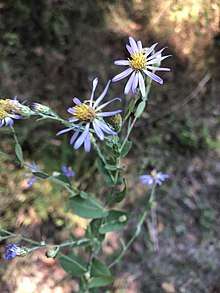Symphyotrichum patens
Symphyotrichum patens, commonly known as late purple aster or spreading aster, is a perennial wildflower found in the eastern United States.[1][2]
| Symphyotrichum patens | |
|---|---|
 | |
| In Davidson County, North Carolina | |
| Scientific classification | |
| Kingdom: | Plantae |
| Clade: | Tracheophytes |
| Clade: | Angiosperms |
| Clade: | Eudicots |
| Clade: | Asterids |
| Order: | Asterales |
| Family: | Asteraceae |
| Genus: | Symphyotrichum |
| Species: | S. patens |
| Binomial name | |
| Symphyotrichum patens | |
 | |
| County-level distribution map of Symphyotrichum patens[1] | |
Description
Sympyotrichum patens is a small (up to ~1m height) herbaceous plant with a spreading growth form. The leaves are ovate to oblong, clasping the pubescent stem.[2][3] The flowers are relatively small, less than 3 cm (1.2 in) in diameter, with light blue to violet petals and yellow centers.[3] It flowers between August and October.[3]
Taxonomy
The genus Symphyotrichum includes some 90 species that are often highly similar.[4] The title of a review of the Symphyotrichum patens complex begins with "Another review..." as a nod to the complexity of the topic.[5] The species was first formally described as Aster patens in 1789.[6] It was transferred to the genus Symphyotrichum in 1995 by Guy L. Nesom.[7] It is closely related to Symphyotrichum georgianum and Symphyotrichum phlogifolium.[5]
Several varieties have been named:[8][5]
- Symphyotrichum patens var. patens
- Symphyotrichum patens var. gracile (Hook.) G.L.Nesom
- Symphyotrichum patens var. patentissimum (Lindl.) G.L.Nesom
- Symphyotrichum patens var. terranigrum J.J.N. Campbell & W.R.Seymour
Distribution and habitat
A widely distributed species, S. patens can be found from southern Maine south and west to East Texas.[1] Plants are typically found in sunny to mostly sunny sites, including open woodlands.[9] Relatively little appears to be known about the species' ecology, with most literature being checklists that include S. patens.
References
- https://plants.usda.gov/core/profile?symbol=SYPA11
- Brouillet, Luc, John C. Semple, Geraldine A. Allen, Kenton L. Chambers, and Scott D. Sundberg (2006). "Symphyotrichum patens (Aiton) G. L. Nesom". In Flora of North America Editorial Committee (ed.). Flora of North America North of Mexico (FNA). 20. New York and Oxford. Retrieved 23 December 2019 – via eFloras.org, Missouri Botanical Garden, St. Louis, MO & Harvard University Herbaria, Cambridge, MA.CS1 maint: uses authors parameter (link)
- http://www.missouribotanicalgarden.org/PlantFinder/PlantFinderDetails.aspx?taxonid=292655&isprofile=0&=
- https://uswildflowers.com/detail.php?SName=Symphyotrichum%20patens
- Campbell, J.J.N. and W.R. Seymour, Jr. 2014. Another review of the Symphyotrichum patens complex (Asteraceae), including a new variety of S. patens from the southern Blacklands, new records of S. georgianum, and notes on georgianum-like plants outside its known range. Phytoneuron 2014-104: 1–33. Published 6 November 2014. ISSN 2153-733X]
- "Aster patens [Dryand.], Hort. Kew. [W. Aiton] 3: 201 (1789)". ipni.org. International Plant Names Index. Retrieved 6 January 2020.
- "Symphyotrichum patens (Aiton) G.L.Nesom, Phytologia 77(3): 288 (1995)". ipni.org. International Plant Names Index. Retrieved 6 January 2020.
- "Symphyotrichum patens (Aiton) G.L.Nesom". Plants of the World Online. Royal Botanic Gardens, Kew. Retrieved 6 January 2020.
- https://plants.ces.ncsu.edu/plants/symphyotrichum-patens/